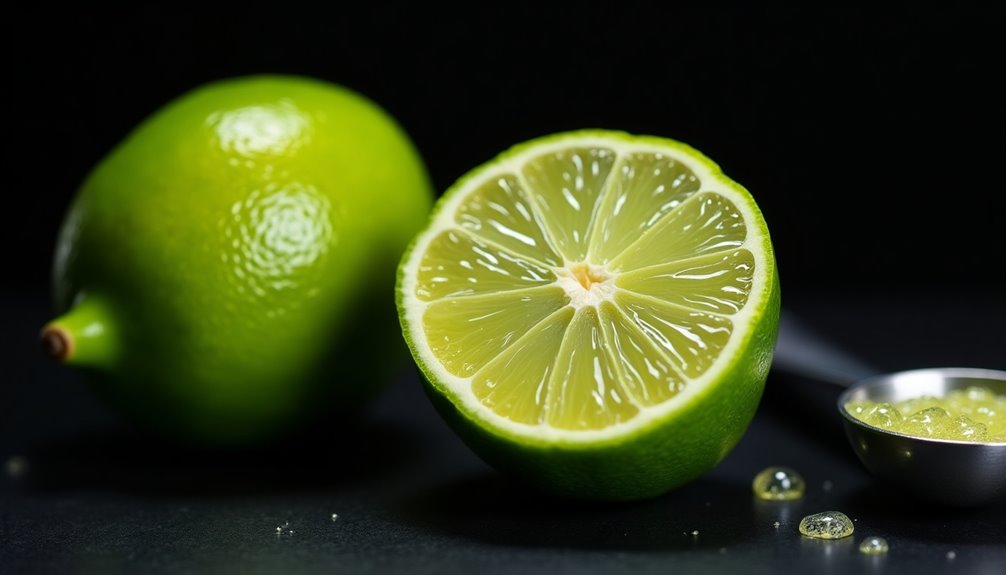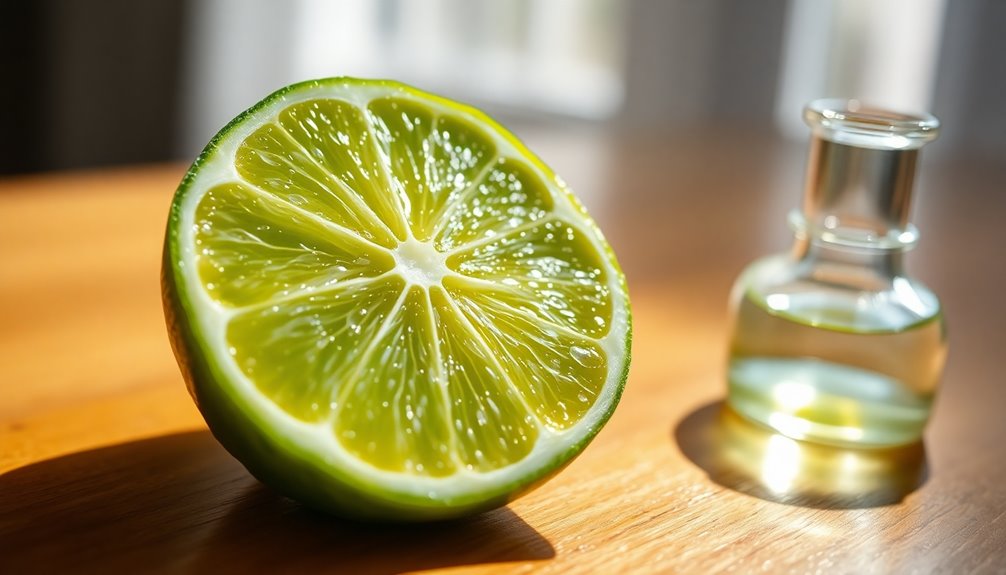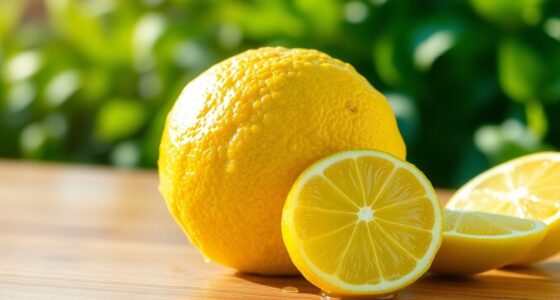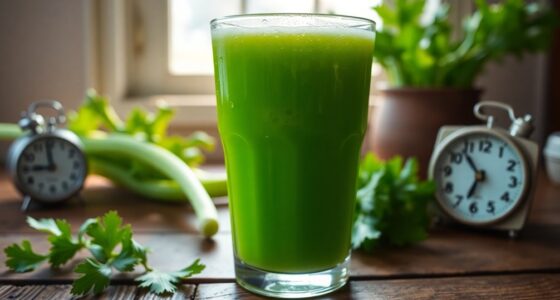A medium lime typically gives you about 2 tablespoons, or 1 ounce, of juice. If you've got a recipe that calls for 1/4 cup of lime juice, you'll need around 2 medium limes to get that amount. To maximize your juice extraction, choose firm, shiny limes and roll them on the countertop before cutting. Fresh limes enhance flavor and provide more juice, so it's worth knowing how to choose the best ones for your needs. You'll discover more helpful tips on maximizing juice efficiency.
Key Takeaways
- A medium lime typically yields about 2 tablespoons (1 ounce) of juice.
- For recipes requiring 1/4 cup of lime juice, approximately 2 medium limes are needed.
- The average number of limes in a pound is around 4 to 5.
- Smaller limes often yield more juice per pound compared to larger ones.
- Fresh, firm limes with shiny skin usually provide more juice and better flavor.

When you slice into a lime, you're not just unlocking a burst of flavor; you're also tapping into a rich source of juice. If you're wondering how much juice you can expect from a single lime, you'll be pleased to know that a medium lime typically yields about 2 tablespoons of juice, which is equivalent to 1 ounce. This might seem small, but it can make a significant difference in your recipes, enhancing everything from cocktails to marinades.
When you're preparing a dish that calls for fresh lime juice, knowing the yield can help you plan better. For instance, if a recipe requires 1/4 cup of lime juice, you'll need about 2 medium limes to meet that requirement. This can save you time and prevent any last-minute dashes to the store.
Keep in mind that the average number of limes in a pound is around 4 to 5. Smaller limes often yield more juice per pound, so if you find yourself with a bag of smaller citrus fruits, you may hit the jackpot with juice extraction.
To get the most out of your limes, there are a few tips you should consider. First, when you're ready to juice, roll the lime firmly on the countertop before cutting it. This simple technique can enhance juice extraction, allowing more of that zesty goodness to flow. You'll find that the process of rolling helps break down the internal membranes, making it easier to release the juice.
A firm, smooth-skinned lime is often an indicator of juiciness. If you pick up a lime and it feels lighter or hard, it likely won't yield as much juice. So, focus on those that feel firm and have a shiny skin.
When you're juicing, don't forget to check the quality of your limes. The freshness of the citrus fruit can significantly impact the flavor and quantity of juice you extract. Fresh limes not only provide more juice but also enhance the overall taste of your dishes.
If you're in a pinch, you might want to keep an eye out for those sturdy, well-formed limes at your local grocery store or market.
Frequently Asked Questions
How Much Juice Is in 1 Lime?
When you’re juicing a lime, you can expect to get about 2 tablespoons or 1 ounce of juice from one medium lime. If you’re looking for comparable measurements, a medium lemon typically yields about 3 tablespoons of juice, slightly more than a lime. For recipes that call for fresh lemon juice measurement details, it’s always helpful to keep a citrus juicer handy to extract the maximum amount of juice without much effort. This way, you’ll get the perfect amount of acidity for your dishes and drinks.
If you need more juice for a recipe, like 1/4 cup, you'll usually want to use 2 limes.
To maximize your yield, choose firm, heavy limes; they tend to have more juice.
Can I Substitute Bottled Lime Juice for Fresh Lime Juice?
You'll find that fresh lime juice is often preferred, as it packs about 2 tablespoons, which adds a vibrant flavor to dishes.
While you can substitute bottled lime juice in a pinch, it mightn't capture the zesty brightness you crave. Bottled versions can taste flat and lack that unique floral quality.
For recipes where lime flavor shines, fresh juice is your best bet to elevate your culinary creations.
What Are the Benefits of Lime in the Body?
Limes offer numerous benefits for your body. They're packed with vitamin C, boosting your immune system and enhancing skin health.
The antioxidants help fight oxidative stress, reducing chronic disease risks. Lime juice aids digestion by stimulating digestive juices and promoting gut health.
Additionally, citric acid may prevent kidney stones by increasing urine volume. Incorporating limes into your diet can also support weight management, as they're low in calories and encourage hydration.
How Many Tsp Is 2 Limes?
If you're using two limes, you can expect to get about 12 teaspoons of juice.
That's roughly 4 tablespoons, which is perfect for many recipes.
Keep in mind that the exact amount can vary slightly based on the size and ripeness of the limes, but generally, two medium limes will provide a consistent yield.
Using fresh limes will enhance your dish's flavor compared to bottled juice, so go for the real thing!
Conclusion
In summation, savoring the small citrus sphere of a lime yields about two tablespoons of vibrant, zesty juice. Whether you're sprucing up a salad, spicing up a sauce, or mixing a marvelous margarita, this little lime packs a powerful punch of flavor. Its bright burst brings balance and brightness to your dishes, making it a kitchen staple. So, the next time you reach for that radiant fruit, remember its juicy joy and culinary contributions!
Cindy thoroughly researches juicing trends, techniques, and recipes to provide readers with practical advice and inspiration. Her writing style is accessible, engaging, and designed to make complex concepts easy to understand. Cindy’s dedication to promoting the advantages of juicing shines through her work, empowering readers to make positive changes in their lives through the simple act of juicing.

















